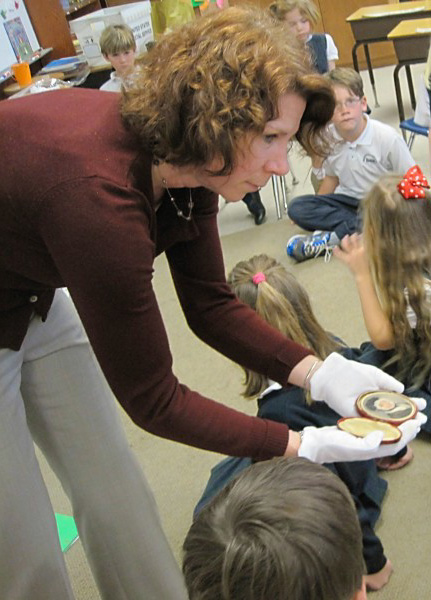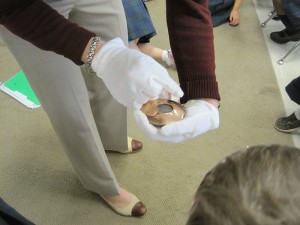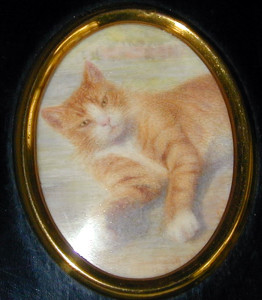I recently had the pleasure of speaking to my son’s second grade class at Blessed Sacrament School as part of their 2012 Career Day. I love talking about what I do and enjoy watching people of all ages consider (often for the first time) what goes on behind the scenes in a museum. As Director of Collections Administration, one of my primary responsibilities is care of the art collection. Whether art objects are on the walls, in storage, moving throughout the museum or traveling nationally or internationally, it is my job to make sure they are safe and cared for properly. It is a great job and I was excited to share my experiences with a lively group of 7 and 8 year olds. I decided to present a modified version of the Behind-the-Scenes Program that Greg Jenkins, Operations Director and Preparator, and I have been offering at the museum for several years. My collections road show included several examples of archival storage containers which prompted discussion on how we preserve (a new word for second graders) art work in a museum. I also brought several small, easily transportable works from the collection to review the proper way to handle art. Miniature portraits were a big hit with this group; the children were amazed by the extraordinary details miniature portraitists produced using water color paint (a medium familiar to second graders).

As part of the program, I also had a selection of reproduction miniature portraits. Each child chose one of these pieces to examine more closely. I explained that all works in the collection have a computer record. These records contain information about the object including its identification number, title, the name of the artist who created it, the object’s location in the museum, a thorough description of the object and notes on its physical condition. The process of recording and describing an object is referred to as cataloging; references to its condition are the condition report. I asked each child to describe their miniature portrait (what the sitter was wearing, hair color, background) and also look for any condition problems (scratches to the frame, loose glass, etc.) Cataloging and creating condition reports are a daily part of my job; this exercise gave the class a basic idea of the process. With their observant eyes, the children provided detailed descriptions of their miniatures and alerted me to many flaws on the frames of our reproduction collection.

Throughout the program I encouraged questions and was both amused and amazed by the variety of queries. Below are a few of my favorites from the Blessed Sacrament second grade.
Q: What would happen if you went to get a painting [from a borrowing institution] and took the wrong one home? (This question was in response to my description of outgoing loans and the fact that I occasionally travel with works from our collection when they are borrowed by other museums.)
A: Great question! If I took home the wrong painting I would probably be in big trouble because it would mean I was not paying attention. Every painting in the Gibbes collection has its own individual identification number called an accession number. The accession number can be found directly on each painting or work on paper. When retrieving a painting from a borrowing institution I have images of the painting as well as the accession number to make certain I take the correct work of art!
Q: Do you run the whole museum? Do you have any help or do you take care of all 10,000 works by yourself?
A: More good questions! I most certainly do not run the entire museum. We have thirteen full-time staff members at the Gibbes, several part-time employees and multitudes of dedicated volunteers and auxiliary groups. All of these individuals form “the Gibbes” and do everything from manage the staff to raise funds for museum operations, create exhibitions and educational programs, organize and manage museum events, keep the building and artwork secure, process museum memberships, oversee finances, lead group tours and much, much more! The Gibbes Museum is fortunate to have such a great team.
The short answer to the second question is yes, I do have help taking care of the art collection! While I oversee the details surrounding care and movement of the objects, there are other members of the curatorial, collections and security staff that help out. For example, Greg Jenkins, our long time museum preparator, hangs all the works in the galleries and makes sure that they are secure on the walls. Our curators contribute to the care of artwork by thoroughly researching the provenance of each piece and sharing that information with the public. They also choose what works will be hung in the exhibitions and decide how they will be arranged, keeping in mind the different sizes and types of objects and how they fit together. And of course our security team plays a huge role in helping me care for our collection. You can find the security crew in the galleries and behind-the-scenes keeping a watchful eye on the artwork.
Q: Do you take care of artwork like you take care of your children?
A: My answer to this is “not exactly.” However, there are similarities in caring for artwork and caring for children. As a parent, it is my responsibility to know where my children are and who is caring for them. Similarly, as Director of Collections Administration, I need to know where the artwork is (what gallery, what storage location, what other venue) and keep track of any location changes. As a parent I make sure that my children are always in a safe environment (at home, at school, with friends). Likewise, at work I constantly monitor the environment in which we exhibit and store the art collection. Museums maintain specific temperature, humidity and light levels to prolong the life of an object. Finally, when my children take a trip, I make sure they are prepared to travel, pack their suitcases and arrange details of how our family will get to our destination. Similarly, when artwork leaves the museum, I oversee all the details regarding packing and transportation to its destination. While I do not pack a suitcase for a painting going out on loan, I do make certain that it is clean, fit for travel, has an appropriate shipping container and is looking its best!

Q: Have you ever seen a miniature portrait with pet hair in the back of the case?
A: This question arose after an extensive discussion of miniature portraits and the surprises that are often found on the backs of miniature cases. I brought a miniature from the museum’s collection that had a lock of the sitter’s hair in a special compartment on the back of the case. This sentimental nineteenth century tradition fascinated the children and generated much speculation as to why people did this. Regarding the question about pet hair, I have seen miniature portraits of animals (we have a lovely miniature by Leila Waring of her cat Dick) but have not come across one that contained a lock of the pet’s hair. I will keep an eye out!

Q: Why don’t you have enough space to show all the paintings in the collection?
A: I informed the second graders that at present, the Gibbes is only able to display about 2-4% of the permanent collection. The reason we cannot exhibit more works is that we are simply out of space. The existing museum building was constructed in 1905 when the art collection contained significantly fewer works. While more gallery space was added over the years the current layout can only accommodate a certain number of works. We rotate objects every six months to give the public a wider view of the depth and breadth of the permanent collection but long for more exhibition space. Thankfully, the Gibbes is headed for a major building renovation and expansion that will finally provide more room to exhibit and store the collection! We are excited to share a larger number of objects from the Gibbes collection once the renovation is complete. Stay tuned for future posts on this exciting project!
Q: Do you work on the weekends?
A: This question made me laugh but the class felt it was extremely important. No, I do not generally work on the weekends. However, there are occasions when a large exhibition installation with a tight schedule necessitates weekend hours to finish on time. There are also occasions where incoming art shipments must occur on a weekend due to the lenders schedule, the shipping route or the numbers and size of crated works. I am always front and center (along with Greg Jenkins) for those weekend deliveries.
Speaking at the Blessed Sacrament Career Day was a great experience. The children were genuinely interested in my job at the Gibbes and their enthusiasm was infectious. Describing your daily work to children and fielding their many questions is a great way to gain perspective on the importance of what we as museum professionals accomplish each day and why we do it. Many of the children told me I had the coolest job in the world. Without hesitation, I have to agree.
—Zinnia Willits, Director of Collections Administration
Published May 2, 2012

